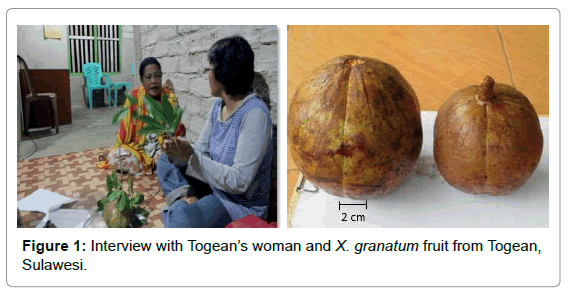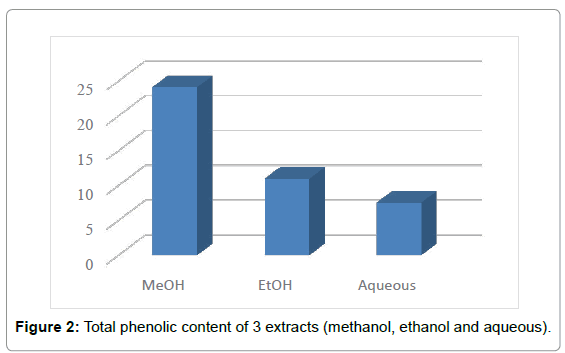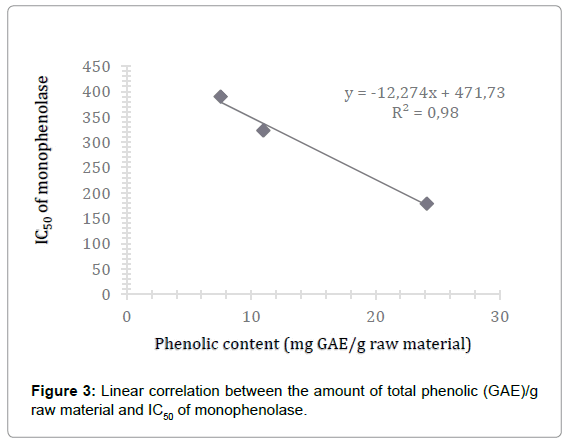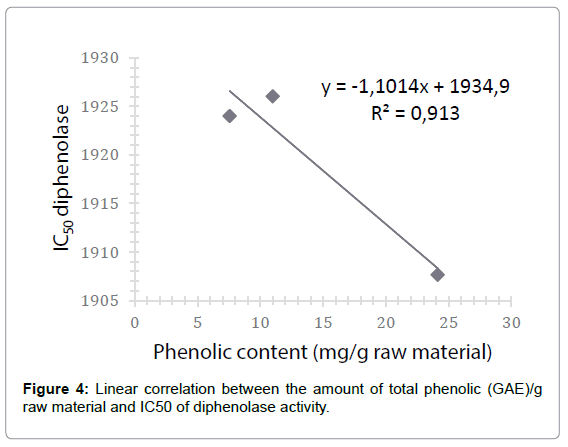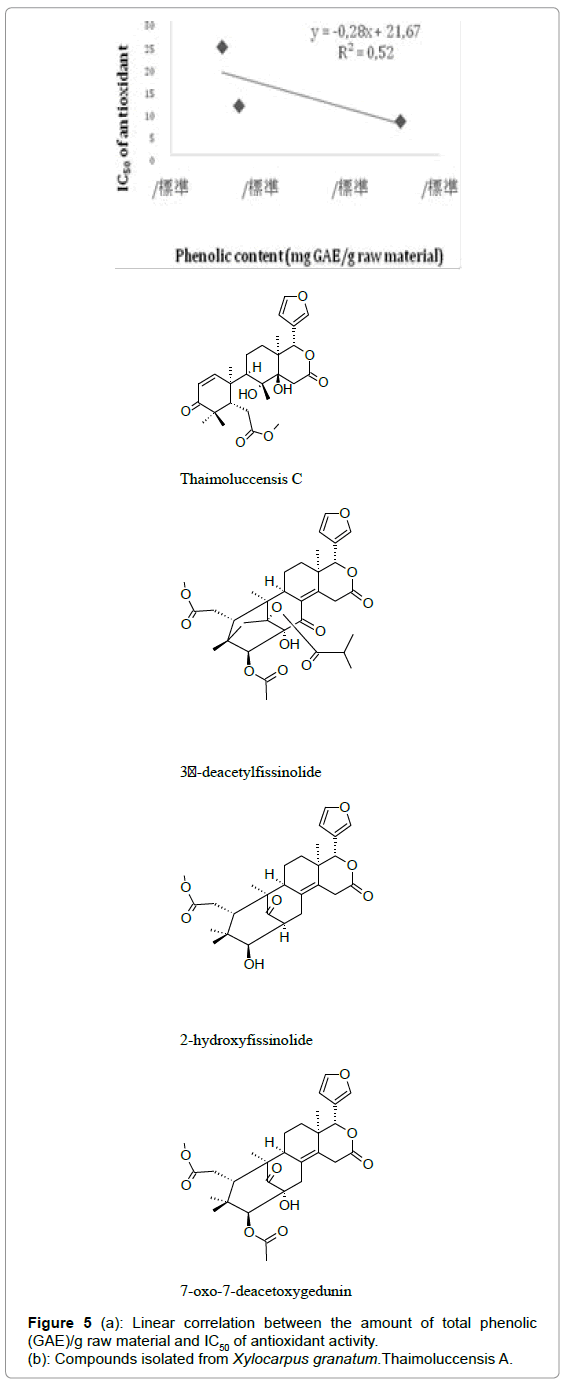Research Article Open Access
The Study of Tyrosinase and Antioxidant Activity of Xylocarpus Granatum Koenig Seed Kernel Extract toward Evidence Based Indigenous Knowledge from Togean Archipelago, Indonesia
Zamani NP1*, Gazali M2 and Batubara I31Bogor Agricultural University, Faculty of Fisheries and Marine Science, Kampus IPB Dramaga, West Java, Indonesia
2Teuku Umar University, Faculty of Fisheries and Marine Science, Meulaboh, Aceh Province, Indonesia
3Bogor Agricultural University, Faculty of Mathematic and Natural Science, Kampus IPB Dramaga, West Java, Indonesia
- *Corresponding Author:
- Zamani NP
Bogor Agricultural University
Faculty of Fisheries and Marine Science
Kampus IPB Dramaga, West Java, Indonesia
Tel: + 622518629131
Fax: + 622518626380
E-mail: np_zamani@yahoo.com
Received date: August 20, 2015; Accepted date: October 16, 2015; Published date: October 22, 2015
Citation: Zamani NP, Gazali M, Batubara I (2015) The Study of Tyrosinase and Antioxidant Activity of Xylocarpus granatum Koenig Seed Kernel Extract toward Evidence Based Indigenous Knowledge from Togean Archipelago, Indonesia. J Marine Sci Res Dev 5:168. doi:10.4172/2155-9910.1000168
Copyright: © 2015 Zamani NP, et al. This is an open-access article distributed under the terms of the Creative Commons Attribution License, which permits unrestricted use, distribution, and reproduction in any medium, provided the original author and source are credited.
Visit for more related articles at Journal of Marine Science: Research & Development
Abstract
The tyrosinase inhibitory activity and antioxidant activity of three (3) extracts (methanol, chloroform,and n-hexane) from seed kernel of Xylocarpus granatum Koenig was tested. The tyrosinase inhibitory activity and antioxidant activity was estimated as IC50 values and the content of total phenolics in extracts was calculated as gallic acid equivalent (GAE). The best result of tyrosinase inhibitory ability was obtained in methanol extract in monophenolase activity (IC50 =323.11 ± 9.0 μg/mL that correlated significantly with the total of phenolic content (R2 =0.98, Y= -12.27x + 471.73) and the antioxidant activity have IC50 = 10.61 ± 0.6 μg/mL. We indicate that this methanolic extract of X. granatum seed kernel posseses potency as tyrosinase inhibitor and antioxidant agent. This result has already shown that the indigenous knowledge in utilization of X. granatum seed kernel for lightening skin has been evident.
Keywords
Antioxidant agent; Tyrosinase inhibitor; Xylocarpus granatum koenig
Introduction
Indonesian traditional medicine known as Jamu is an all natural medicine involving the use of natural natural resources including plants, animal and minerals. Originally, Jamu was a term used for Javanese traditional medicine, but how it is used as general term pertaining to Indonesian Traditional medicine. Indonesia is consist of 17.508 islands [1] and each area has own specific traditional medicine. The use of plants and other natural resources for medicinal purposes in Indonesia dates back to pre-historic times. Knowledge of indonesian traditional medicine has been passed down from generations to generations. About 300 distinct native ethnicities live in Indonesia and each ethnic group has used indigenous knowledge to develop folklore medicine based on availability of material in their own area. There have been a few studies of the traditional medicine of the indigenous tribal people of Togean (Sulawesi). Many local communities in Togean archipelago have already been utilized coastal plant for curing disease, health care, beauty care (cosmetic), tonic and sunscreen. Unfortunately, the use of medicinal plants by coastal community has not yet been documented well. Moreover, mangrove’s finding for lightening product already becomes a national patent from searching of indigenous knowledge in coastal area.
Coastal area of Indonesia is famous for its richness and biodiversity. One of the coastal ecosystem that provide natural resources for human life isa mangrove. Mangrove in Indonesia possess the highest biodiversity in the word with a total of 89 species, consisting of 35 species of plants, 9 species shrubs, 9 species of lianas, 29 species of epiphytes, and two species of parasitic.Mangroves biodiversity is a high valuable asset due to the ecological benefits as a source of food and traditional medicine. The extensive use of natural plants, such as mangrove, as health remedies due to their pharmacological properties is quite common. The investigation of efficacy of plant-based drugs has been paid great attention because of their side effects, cheap and easy availability. According World Health Organization (WHO) around 80% of the world people still rely mainly on plant drugs [2,3]. Mangrove plant has already been used as bioactive compound resources such as alkaloid, phenolic and steroid [4,5].
Many species of mangrove that uses traditional medicine, for instance, Xylocarpus granatum Koenig, local name in Indonesia is Nyirih have many activities such as antibacterial [6], antidiarrheal [7], antifeedant [8], cytotoxicity [9], tyrosinase and antioxidant activities [10]. Xylocarpus granatumis one species of Meliaceae family have been traditionally used for medicine by South East Asia shoreline inhabitants. Bioactive compounds of X. granatum have been known such as triterpenoid, alkaloids, phenolic acids, flavanol, stroids, and monoterpenoids [11].
Finding skin lightening agent from natural sources is one of our research focuses. To decrease hyperpigmentation and oxidative stress on skin, we need to reduce the formation of melanin in the human body. The formation of melanin in human body is influenced or reduced by several mechanisms, including antioxidant, direct tyrosinase inhibition, melanin inhibition of migration from cell to cell and hormonal activities, etc., [12,13].
Tyrosinase (EC 1.14.18.1), a copper-containing monooxygenase, is a key enzyme that catalyzes melanin synthesis in melanocytes [14,15]. It catalyzes two major reactions, including hydroxylation of L-tyrosine and oxidation of the o-diphenol product, L-DOPA (3,4-dihydroxyphenylalanine). DOPA oxidation produces a highly reactive intermediate that is further oxidized to form melanin by a free radical-coupling pathway. If free radicals are inappropriately processes in melanin synthesis, hydrogen peroxide (H2O2) is generated, leading to the production of hydroxyl radical (HO-) and other reactive oxygen species (ROS) [16]. Oxidative stress may be caused by increasing generation of (ROS) and other free radicals. These ROS enhance melanin biosynthesis, damage DNA and may induce proliferation of melanocytes [17]. Yamakoshi et al. [18] also found evidence that oxidative stress plays a role in the pathogenesis of skin disorders.. Besides, ROS scavanger such as antioxidants may reduce hyperpigmentation [19].
The utilization of X. granatum seed kernel as tyrosinase inhibitor and antioxidant substances have not been explored which that this part have already been used by Togean’s women for skin care passed down through their ancestor. The objectives of this study were to examine the tyrosinase inhibition and antioxidant activity of X. granatum seed kernel extracts. This result will be toward evidence of indigenous knowledge from Togean Archipelago, Sulawesi.
Materials and Methods
Plant material
X. granatum seed kernel was collected from Bangkagi Coast Archipelagic of Togean, Central Sulawesi in July 2013. Specimen sample (voucher number 1918291) has been identified and deposited in Herbarium Bogoriense Bogor, Indonesian Institute of Sciences (LIPI) Cibinong, West Java, Indonesia.
Chemical and instruments
Mushroom tyrosinase (Sigma Aldirch), L-Tyrosine (Merck), L-DOPA. Kojic acid was obtained from Sigma (μgmL1), DPPH (2,2-diphenyl-1- picrylhydrazyl) and ascorbate acid were purchased from Sigma (Checz Republic). Folin-Ciocalteu’s phenol reagent, gallic acid, ELISA plate well reader and UV-VIS Spectrophotometer (USA).
Preparation of plant extracts
X. granatum seed kernel was dried and grounded before extraction process. Extraction was performed by using maceration method with 3 different solvents namely n-hexane, chloroform and methanol (25 g sample: 75 mL solvent) for 24 h in triplicate. The extracts were filtered using Whatman filter paper (No. 2) and concentrated in vocuo at 30°C using a rotary. The yields of extracts were calculated.
Phytochemical screening
The preliminary phytochemical screening of various active compound from X. granatum seed kernel were accomplished.
Detection of tannins [20]: 10 ml of the ethanolic extract (70% of seed kernel of this plant were filtered by filter paper. Many drops of ferric chloride reagent (FeCl3) (1%) have been added to the different filtered extracts. The presence of tannins is indicated by a blue color.
Detection of saponins [21]: The test tube containing each the previous filtered extracts were shacked for 5 minutes using a vortex. The apperance of big foamy indicates the presence of saponins.
Detection of alkaloids [21]: 0.2 g of the powder of two parts of this plant was dissolved in 10 ml of HCl 1%. Then, they were transferred to a water bath for few minutes. After, 1 ml of the filtrated extract was treated with 2-4 drops of dragendorff’s reagent. The presence of alkaloid is indicated by the appearance of an orange reddish precipitation.
Detection of terpenoids [20]: 1 ml of acetic anhydride and 2ml of concentrated sulphuric acid were added to beaker containing 1ml of previous extracts.The presence of reddish brown on the interface indicated the presence of terpenoids.
Detection of flavonoids [22]: Two solution A and B from both part of the plant extract were prepared. The solution A contains 5 ml of ethanolic extract previously prepared. The solution B is consist of 5 ml of ethanolic solvent added to 5ml of KOH (50%). Then the two solution A and B were mixed together. The presence of flavonoid is indicated by appearance of yellow color.
Tyrosinase activity test
This assay was performed using methods as described earlier [10,23,24]. Our extracts were dissolved in DMSO (dimethyl sulphoxide) to a final concentration of 20 mg/ml. This extract stock solution was then diluted to 600 μg/mL in 50 mM potassium phosphate buffer(pH 6.5).The extracts were tested at the concentrations ranging from 7.812 to 500 μg/mL in a 96-well plate, 70 μL of each extract dilution was combined with 30 μL of tyrosinase (Sigma, 333 Units/mL in phosphate buffer) in triplicate. After incubation at room temperature for 5 min, 11 μL of substrate (2 mM L-tyrosinase or 12 mM L-DOPA) was added to each well. Incubation commenced for 30 min at room temperature. Optical densities of wells were then determined at 492 nm with multiwell plate reader. The tyrosinase activities (monophenolase and diphenolase activities) were analyzed in the present extract of X. granatum seed kernel compared to control. Kojic acid (Sigma, Checz Republic) was used as positive control.
Antioxidant assay
The antioxidant activity test was performed using 1,1-diphenyl-2- picryhydrazyl (DPPH) as described in [25].
Total phenolic content (TPC)
Total phenolic content of the extracts obtained from solvents having different dielectrict constant values was measured at 725 nm using Folin-Ciocalteau spectrophotometric method with sligthly modification [26]. The extract were mixed with Folin Ciocalteu reagent for 5 min, 5% Na2CO3 was then added and final volume made up to 25 mL with distilled water. After 60 min the absorbance was measured at 725 nm. Total phenol content was expressed as mg gallic acid equivalents (GAE)/100 g tissue.
Statistical analysis
Data of tyrosinase inhibitory and antioxidant activity were calculated as follow in Equation 1
% inhibition=[(A-B)/A] × 100
Where :
A is the absorbance of blank
B is the absorbance of sample
Its correlation between total flavonoid content and tyrosinase inhibition as well as antioxidant a activity were analyzed with correlation test , r=+1 (positive correlation), r=0 (no correlation) and r=-1 (negative correlation). All data were calculated using the microsoft excell computer program.
Result and Discussion
Xylocarpus granatum seed kernel extract
The extraction of X. granatum seed kernel resulted rendement of methanolic extract is 21.48% whereas the rendement of chloroform extract is 1.87% and n-hexane extract is 1.97%. Three extracts of X. granatum seed kernel, namely methanol, chloroform, n-hexane extracts contain different secondary metabolite content (Table 1). Methanolic extract contained polar type compound such as phenolic compound groups (flavonoid and tannin) and saponin while chloroform and n-hexane extracts which contain semi-polar and non polar type compound were not consisted of flavonoid, tannin and saponin. According to Chang [27] that X. granatum species contains flavonoid compound group which are potent as tyrosinase inhibitor and antioxidant.
| Phytochemical Properties | Extracts | ||
|---|---|---|---|
| n-hexane | Chloroform | Methanol | |
| Flavonoid | - | - | + |
| Saponin | - | - | + |
| Tannin | - | - | + |
Tabel 1: Phytochemical components of X. granatum seed kernel.
Based on the different constituents includingn-hexane, chloroform and methanol extracts. We screened their tyrosinase inhibitory activity (monophenolase and diphenolase) and also antioxidant activity. This result on Table 2 shown that tyrosinase inhibitory activity of X. granatum seed kernel methanolic extract is the best extracts which can inhibit monophenolase (IC50=323.11 ± 9.0 μg/mL) and diphenolase activity(IC50=1926.03 ± 81 μg/mL) with kojic acid as postive control. Futhermore, the methanolic extract also has antioxidant activity (IC50=10.61 ± 2.1 μg/mL). Moreover, n-hexane and chloroform extracts have no IC50 value until concentration of 2000 μg/mL for tyrosinase inhibition and 100 μg/mL for antioxidant. These result shown that nonpolar and semi-polar compound in X. granatum seed kernelhas not possess ability in inhibition of tyrosinase and antioxidant activities.
| Extract | IC50(μg/mL) Monophenolase | IC50(μg/mL)Diphenolase | IC50(μg/mL) Antioxidant |
|---|---|---|---|
| Methanol | 323.11 ± 9.0 | 1926.03 ± 81 | 10.61±2.1 |
| Chloroform | -* | -* | -* |
| n-hexane | -* | -* | -* |
| Aqueous | -* | -* | -* |
| Kojic acid | 46 ± 0.9 | 204.08 ± 0.9 | |
| Ascobate Acid | 2.11 ± 0.6 |
Note: IC50 =Concentration of extract can inhibit tyrosinase activity as much as 50%: -* :it didnâ�?�?t achieve 50% inhibition at maximum concentration of 2000 �?µg/mL. For antioxidant activity can achieve 50% inhibition at maximum concentration of 100 �?µg/mL.
Tabel 2: Tyrosinase IC50 value of three extracts from X. granatum seed kernel.
Previous study stated that X. granatum wood have already been tyrosinase inhibitory and antioxidant activity [10]. The part of X. granatum stem and bark also possess potency as tyrosinase inhibitor [28] and X. granatum fruit peel also have tyrosinase inhibitory and antioxidant activities [29]. Thus, X. granatum seed kernel extract that tested their bioactivity in tyrosinase inhibition and antioxidant activities was new finding based indigenous knowledge in Togean Archipelago, Sulawesi (Figure 1).
These result addressed the truth of indigenous knowledge from Togean Archipelago in utilizing of X. granatum seed kernel by Togean’s women as lightening product. According to interview with Togean’s women that mangrove X. granatum in Togean Archipelago was abundant especially in Bangkagi Coast. The extent of X. granatum species estimated about ± 17 hectares. Flowering and fruiting throughout year. In India, the seed kernel of X. granatum are used as tonic [7]. Unfortunately, X. granatum species have decreased because utilization of wood for making of boat, brigde, charcoal and others. Thus, we conducted socialization of mangrove conservation to local community to keep sustainablity of X. granatum species.
Therefore, new finding of tyrosinase inhibitor and antioxidant agent from X. granatum seed kernel give fruitfull information for cosmeceutical industry. All X. granatum parts could be complementary each other in providing the raw material of cosmetic product. Great concern in searching natural compound particularly X. granatum that explored by scientist to tackle problem concerning aesthetic and dermatology. Thus, X. granatum species constitutes prospective marine plant for cosmeceutical interest. This utilization still traditionally used by coastal community for skin care.
Total phenolic content
Total phenolic of three extracts (methanol, ethanol and aquous) and its extract were expressed as gram gallic acid equivalent/100 g dry material. The amount of total phenolic content varied in 3 extracts ranged from 7.55 to 24.12 gram gallic acid equivalent/100 gram dry material. The highest total phenolic contents were detected in “methanolic extract” and the lowest in “water extract”. (Figure 2).
Its correlation coefficient of R2=0.98, (Y= -12.27x + 471.73) whereas for IC50 of diphenolase (Figure 3) had a correlation coefficient of R2=0.52, (Y= -0.28x + 25.67) (Figure 4). These results suggested positive correlation of monophenolase and diphenolase activity with tyrosinase activity, the antioxidant activity of three extracts wasnot limited to phenolics. Activity may also come from the presence of other antioxidant secondary metabolites like e limonoid, alkoloid and hidroquinone. Somecompounds such as thaimoluccensis A, thaimoluccensis C, 3β-deacetylfissinolide, 7-oxo-7-deacetoxygedunin, could be involve to the skin care since these compounds had been isolated and reported as anti-inflammatory activities [30]. Structure the two compounds is shown in Figure 5.
Conclusion
Part of X. granatum seed kernelhave potential as tyrosinase inihbitor and antioxidant agent. It shown the truth of indigenous knowlegde in utilizing X. granatum seed kernel by Togean’s women as skin lightening have been scientifically proved by this research.
Acknowledgements
I would like to thank to Yasin Labente (Leader of Togean’s community) that helped us to collected mangrove specimen and ecology research in Bangkagi Coast. This research supported by Higher Education Directorate of National Education Department of Republic of Indonesia (Excellence Research accordance Center Mandate No.2013.089.521219).
References
- Coppola BP(2008)SelamatDatang di Indonesia: Learning about Chemistry and Chemistry Education in Indonesia. JCE 85: 1204-1209.
- World Health Organization (1978) The promotion and development of traditional medicine.Technical report series 622. Geneva 1-41.
- Bandaranayake WM (1998) Traditional and medicinal uses of mangroves. Mangroves and Salt Marshes 2: 133-148.
- Bandaranayake WM(2002)Bioactivities, bioactive compounds and chemical constituents of mangrove plants. Wetland Ecology Mangrove10: 421-452.
- Kokpol U, Chavasiri W,Chittawongand V, Miles DH(1990)Taraxerylcis-p-hydroxycinnamate, a novel taraxeryl from Rhizophoraapiculata. J Nat Prod53: 953-955.
- Alam MA, Sarder M, Awal MA, Sikder MMH, Daulla KA(2006) Antibacterial Activity of the Crude Ethanolic Extract of XylocarpusgranatumStem Bark. Bangl J vet Med 4: 69-72.
- Vijai L, MahendraS,Raghubir R(2011)Antidiarrhoeal activity in seed kernels of Xylocarpusgranatum.Asian J Pharm Boil ResVol 1: 62-66.
- Wu J,Zhang S, Bruhn T, Qiang Xiao, Haixin Ding, et al. (2008)Xylogranatins F-R:antifeedants from the Chinese Mangrove, Xylocarpusgranatum,a new biogenetic pathway to tetranortriterpenoids. ChemEur J 14: 1129-1144.
- Firdaus M(2011)Cytotoxicity, Antioxidant and Antimicrobial Activity of Methanol Extract of Bark (Xylocarpusgranatum). Proceeding of the international Conference on Basic Science.
- Batubara I, Darusman LK, Mitsunaga T, Rahmiwati M, Djauhari E(2010) Potency of Indonesian Medicinal Plants a Tyrosinase Inhibitor and Antioxidant Agent. J BiolScie 10:138-144.
- Shen LR, Guo D, Yu YM, Yin BW, Zhao L, et al. (2009) Chemical constituents of plants from the genus Xylocarpus. ChemBiodivers 6: 1293-1308.
- Pawelek JM, Korner AM(1982)The biosynthesis of mammalian melanin. ArnSci 70: 136-145.
- Prota G, Thomson RH(1976) Melanin pigmentation in mammals. Endeavor: 35: 32-38.
- Sturm RA, Teasdale RD, Box NF (2001) Human Pigmentation genes: identification, structure and consequences of polymorphic variation. Gene. 227:49-62.
- Ha YM, Chun SW, Song S,Lee H, Suh H et al. (2007) 4-(6-Hydroxy-2-naphthyl)-1,3-bezendiol: A potent, new tyrosinase inhibitor. BiolPharm Bull30: 1711-1715.
- Perluigi M, De MarcoF, Foppoli C, Coccia R, Blarzino C, et al. (2003) Tyrosinase protects human melanocytes from ROS-generating compounds. BiochemBiophys Res Comm 305: 250-256.
- Yasui H, Sakurai H(2003) Age-dependent generation of reactive oxygen species in the skin of live hairless rats exposed to UVA light. Exp Dermatol 12: 655-661.
- YamakoshiJ, Otsuka F,Sano A,Tokutake S, Saito M, et al.(2003) Lightening effect on ultraviolet-induced pigmentation of guinea pig skin by oral administration of a proanthocyanidin-rich extract from grape seeds. Pigment CellRes 16: 629-638.
- Ma W, Wlaschek M, Tantcheva-Poor I, Schneider LA, Naderi L, et al. (2001) Chronologicalageing and photoageing of the fibroblasts and the dermal connective tissue. ClinExpDermatol 26: 592-599.
- AiyegoroOA, Okoh AI(2010) Preliminary phytochemicalscreening and in vitro antioxidant activities o the aqueous extract of Helichrysum longifolium DC. BMC Complement Altern Med10:21.
- Harborne JB (1984) Phytochemical Method: A guide to modern techhniques of plant analysis. Second edition. Chapman and Hall. New York.
- Nerya O, Musa R, Khatib S, Tamir S, Vaya J(2004) Chalcones as potent tyrosinase inhibitors: the effect of hydroxyl position sand numbers.Phytochemistry 65: 1389-1395.
- Curto EV, Kwong C, Hermersdosfer H, Glatt H, Santis C, et al.(1999) Inhibitor of mammalian melanocytetyrosinase: in vitro comparisons of alkyl esters of gentisic acid with other putative inhibitor. Biochem Pharm 57: 663-672.
- Nerya O,Vaya J,Musa R, Izrael S,Ben-Arie R,et al. (2003) Glabrene and isoquiritigenin as tyrosinase inhibitor from liquoriceroots.JAgrFoodChem 15: 1201-1207.
- Batubara I,Mitsunaga T, Ohashi H (2009) Screening anti-acne potency of Indonesia medicinal plants: Antibacterial, lipase inhibition and antioxidant activities. JWood Sci 55:230-235.
- Amin I, Zamaliah MM, Chin WF(2004) Total antioxidant activity and phenolic content in selected vegetables. Food Chem 87: 581-586.
- Chang TS(2009)An updated review of tyrosinase inhibitor. IntJ MolSci 10: 2440-2475.
- Darusman LK, Batubara I,Lopolisa C(2011) Screening marker components of tyrosinase inhibitor from Xylocarpusgranatumstem. Valensi 2: 409-413.
- Gazali M, Zamani N, Batubara I (2014) Potency of waste fruit peel of Xylocarpusgranatum as a tyrosinase inhibitor. DEPIK JurnalIlmu-IlmuPerairan, PesisirdanPerikanan 3: 187-194.
- Ravangpai W, Sommit D, Teerawatananond T, Sinpranee N, Palaga T, et al. (2011) Limonoids from seeds of Thai Xylocarpusmoluccensis. Bioorg Med ChemLett 21: 4485-4489.
Relevant Topics
- Algal Blooms
- Blue Carbon Sequestration
- Brackish Water
- Catfish
- Coral Bleaching
- Coral Reefs
- Deep Sea Fish
- Deep Sea Mining
- Ichthyoplankton
- Mangrove Ecosystem
- Marine Engineering
- Marine Fisheries
- Marine Mammal Research
- Marine Microbiome Analysis
- Marine Pollution
- Marine Reptiles
- Marine Science
- Ocean Currents
- Photoendosymbiosis
- Reef Biology
- Sea Food
- Sea Grass
- Sea Transportation
- Seaweed
Recommended Journals
Article Tools
Article Usage
- Total views: 15993
- [From(publication date):
December-2015 - Mar 31, 2025] - Breakdown by view type
- HTML page views : 11354
- PDF downloads : 4639

